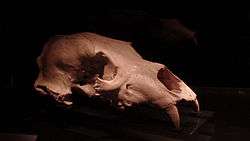Ursus deningeri
| Ursus deningeri Temporal range: Early Pleistocene–Late Pleistocene | |
|---|---|
 | |
| Skull from Atapuerca | |
| Scientific classification | |
| Kingdom: | Animalia |
| Phylum: | Chordata |
| Class: | Mammalia |
| Order: | Carnivora |
| Suborder: | Caniformia |
| Superfamily: | Arctoidea |
| Family: | Ursidae |
| Subfamily: | Ursinae |
| Tribe: | Ursini |
| Genus: | Ursus |
| Species: | Ursus deningeri Richenau, 1904 [1][2] |
Ursus deningeri (Deninger's bear) is an extinct species of mammal of the family Ursidae (bears), endemic to Eurasia during the Pleistocene for approximately 1.7 million years, from ~1.8 Mya to 100,000 years ago.
The range of this bear has been found to encompass both Europe and Asia, demonstrating the ability of the species to adapt to many Pleistocene environments.
U. deningeri is a descendant of U. savini and an ancestor of U. spelaeus.
Morphology

Ursus deningeri has a combination of primitive and derived characters that distinguishes it from all other Pleistocene bears. Its mandible is slender like that of living brown bears and Ursus etruscus. It also has derived characters of cave bears (Ursus spelaeus) and is considered to be the descendant of Ursus savini and very close to the common ancestor of brown bears.[3]
Fossil distribution
Sites and specimen ages:
- Nalaikha, Mongolia: ~1.8 Mya to 800,000 years ago
- West Runton Freshwater Bed, Cromer Forest Bed Formation, Norfolk, England: ~800,000–100,000 years ago
- Cueva del Agua, Granada, Spain: ~800,000–100,000 years ago
- Venosa bed excavations 1974–1976, Basilicata, Italy: ~800,000–100,000 years ago
- Emirkaya-2, Central Anatolia, Turkey: ~800,000–100,000 years ago
- Sima de los Huesos, Atapuerca, Spain: >300,000 years ago[4]
- Darband Cave, Alborz, Caspian, Iran: ~300,000–200,000 years ago
- Stránská skála (Ursus Cave), Brno, Moravia, Czech Republic:excavations 1943-1944 ~790,000–600,000 years ago[5][6]
Genetics
In 2013, a German team reconstructed the mitochondrial genome of an Ursus deningeri more than 300,000 years old, proving that authentic ancient DNA can be preserved for hundreds of thousand years outside of permafrost.[7]
References
Biglari, F., V. Jahani (2011). "The Pleistocene Human Settlement in Gilan, Southwest Caspian Sea: Recent Research.". Eurasian Prehistory 8 (1–8 (1–2): 3–28.
- ↑
- ↑ ENDOCRANIAL MORPHOLOGY OF THE URSUS DENINGERI VON REICHENAU 1904 FROM THE SIMA DE LOS HUESOS (SIERRA DE ATAPUERCA) MIDDLE PLEISTOCENE SITE Journal of Vertebrate Paleontology
- ↑ Nuria García and Juan Luis Arsuaga, Department of Paleontology, Ciudad University, 2001
- ↑ Publication in PNAS.
- ↑ Early pleistocene of Stránská skála Hill
- ↑ Musil, Rudolf (ed.1995): Stránská skála Hill. Excavation of open-air sediments 1964-1972. Antropos, Brno 1995, ISBN 3-7749-2798-7
- ↑ Dabney & al. 2013. PNAS. "Complete mitochondrial genome sequence of a Middle Pleistocene cave bear reconstructed from ultrashort DNA fragments" doi: 10.1073/pnas.1314445110 PNAS